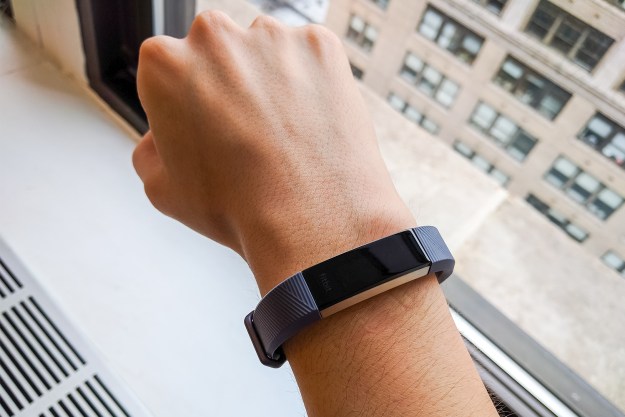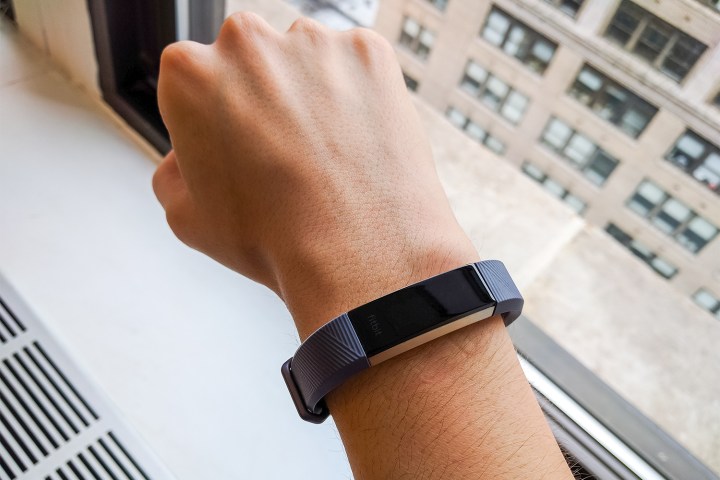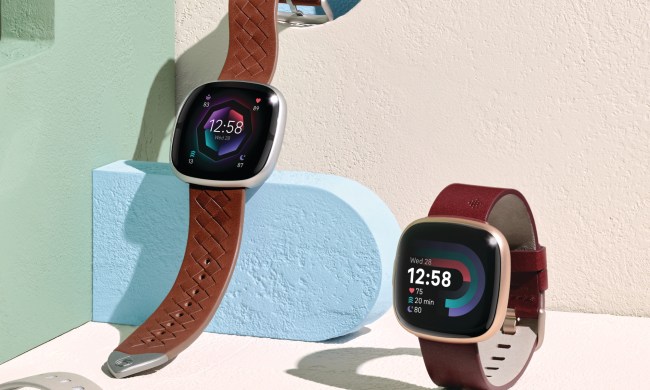
- Slim, sleek, and unobtrusive design
- Precise heart-rate tracking
- Impressive activity recognition
- Useful sleep-tracking data
- Dim, finicky screen
- Not waterproof
- No manual fitness profiles or relaxation features
Not much can be said about fitness trackers that hasn’t already been written. The wrist-worn wearables record your steps, calories, and other metrics to help you to lose your love handles — or at the very least, feel less guilty about the leftover pizza you had for breakfast.
Fitbit’s the undisputed king of these trackers, shipping 5.7 million devices in the second quarter of 2016 and capturing 25 percent of the global fitness market. But even incumbents can’t afford to rest on their laurels. That’s where the Alta HR, Fitbit’s newest tracker, comes in.
Fitbit’s Alta HR improves upon last year’s Alta with sleep-tracking and heart rate-monitoring features — all in a slim, compact frame. We came away impressed by the device’s accuracy when tracking heart rate. While we wish the body was waterproof, and the display was a little easier to activate, we think the Alta HR is one of the best fitness trackers you can buy at its price point.
Compact frame, dim screen
It’s near impossible to tell the Alta HR apart from its predecessor, and that’s a good thing — both are among the thinnest, sleekest fitness trackers we’ve used.
The Alta HR boasts a stylish aluminum body with tapered symmetrical edges. On top sits a curved screen with thick black borders, and underneath is a PurePulse heart-rate sensor and three-pin charging port.
It’s one of the thinnest, sleekest fitness trackers we’ve used.
Fitbit claims Alta HR is one of the smallest wearables on the market with continuous heart-rate tracking, and that seems likely — it’s tiny. The company said it shrunk the internal tech by 25 percent to make room for the optical heart-rate monitor, and the smallest model – the unit we reviewed — measures a mere 0.61 inches (16mm) wide.
The Alta HR’s wristbands are interchangeable, with alternative options available in elastomer, leather, and metal. But unlike last year’s Alta, which used a prong closure to secure the tracker around your wrist, the HR’s band adopts an adjustable watch-like buckle that’s much easier to fasten. It’s also a lot more comfortable to wear all day — I tended to forget I was wearing it.
That being said, there’s definitely room for improvement.
The Alta HR’s monochrome OLED screen isn’t touch-sensitive — instead, tap the screen to cycle through statistics screens, call and text message notifications, and activity reminders. Unfortunately, it’s too dim to read in direct sunlight, and isn’t very responsive.
Sometimes, I had to tap the screen multiple times to get the Alta HR to wake up, and usually a few more times to cycle between stats. The problem is mitigated somewhat by the Fitbit companion app, which lets you specify which stat you see when you lift your wrist. But it’s frustrating nonetheless — especially during a run or workout when tapping the screen can be a quick way to glance at missed notifications.
The band isn’t as skin-conforming as we would have liked. Even at the tightest setting, we had a tough time ensuring the Alta HR’s heart-rate tracker stayed in contact with the wrist.
Sadly, the Alta HR also isn’t waterproof. Unlike Fitbit’s Flex 2, it won’t track your laps or strokes. It’s a feature we would like to see trickle down into all fitness trackers, as sportier devices have the tendency to get into contact with water more often than other devices.
Accurate heart-rate tracking
A heart-rate sensor isn’t the Alta HR’s only headlining improvement — there are quite a few features it inherited from the pricier Charge 2. The Alta HR can track daily activity, monitor heart rate, steps, calories, distance, and can automatically recognize exercises. It can track movement and heart rate while you sleep, and can provide insight on the efficacy (or inefficacy) of your workout routine.
Fitbit pegs the accuracy of Alta HR’s heart-rate tracking to within 6 beats-per-minute, with a margin of error less than 6 percent. In our testing, it stayed well within that range.
SmartTrack automatically records walks, runs, cycling sessions, elliptical routines, and more.
Unlike the wildly inaccurate Pebble 2, the Alta HR was consistently spot on. A sedentary afternoon at the office had it hovering around the low 60s, and a sweaty session of virtual reality gaming got it to the 140s. It responded quickly to ramp-ups in activity, reporting a new BMP within a few seconds of high-intensity sessions.
Perhaps more impressive than the Alta HR’s heart-rate tracking is SmartTrack, the auto-recognition feature that Fitbit introduced last year. It automatically categorizes walks, runs, cycling sessions, elliptical routines, and broader activities like “sports” and “aerobics” after a session. In our testing, the Alta HR’s tracking had no trouble differentiating a treadmill session at the gym from a walk to my apartment. It even suggested an appropriate category — aerobics — for the aforementioned VR session.
It’s a key feature, mainly because it’s impossible to manually start a workout on the Alta HR — you have to wait until you’re done exercising and log workouts in Fitbit’s smartphone app. If most of your routines are stationary or on machines, that could get frustrating.
The Charge 2’s workout profiles aren’t available — you won’t get tracking settings for running, biking, Zumba, or intervals, for example. There’s no GPS and altimeter as well, which makes outdoor runs a little harder to track — you don’t get a route map at the end of each session, or a step-climbing metric. It’s also missing the Charge 2’s guided Relax sessions, the two- and five-minute visualizations that prompt you to breath and slow down your heart rate.
Fitbit justifies these omissions with improved software.
The Fitbit app, which has been updated to support the Alta HR’s tracking features, hasn’t changed all that much since that last time we reviewed it. The home screen shows basic stats like the number of steps you’ve taken, the distance you’ve walked, the calories you’ve burned, the minutes you’ve been active, and the number of days you’ve exercised in a given week. Scroll down a little and you’ll see your heart rate in BPM and your weight.
Fitbit makes liberal use of charts. Tapping on the Steps graphic pulls up a bar graph of activity, with a line indicating your daily goal. An Exercise tab breaks your activities into zones like “cardio” and “fat burn,” and shows the total number of calories you expended. And the Heart Rate section charts your BPM over time, and compares your cardio fitness to others in your age group.
Relatively new additions include the Challenges and Guidance tabs. The Challenges tab packs location-based activities like “Weekend Warrior” (a two-day session of high-intensity workouts), and “Jogging in NYC” (a three-mile run in Manhattan). The Guidance tab, meanwhile, offers workouts from Fitbit’s Fitstar app.
Sleep insights
Sleep tracking is the other new feature. Two new sections, Sleep Insights and Sleep Stages, show how well you’re sleeping each night. A graph breaks your sleep into four stages — Awake, REM, Light, and Deep — and estimates how much time you’ve spent in each.
The screen is too dim to read in direct sunlight, and isn’t very responsive.
Fitbit said the Alta HR uses a combination of heart rate and movement data to determine how long you’ve in each sleep stage. During the different stages, your heart rate variability — the interval of time in between heart beats — changes, and so the Alta HR continuously records it throughout the night. The data’s plotted on a colorful graph that shows the previous night’s info, your 30-day average. and sleep stats from Fitbit users of the same age and gender.
Sleep tracking seemed accurate in our testing. During one particularly restless evening, the Alta HR recorded each hour of disrupted sleep — 2 a.m., 5 a.m., 6 a.m., and 7:30 a.m. It showed that I’d slept for a total of six hours, and 20 percent of that time was spent in Light sleep. The app said most people my age and gender spend a lot longer in that sleep stage than I did. Good to know, but what can I do with this information?
That’s where Sleep Insights come in. They’re in-app cards that give suggestions on how to improve your night’s sleep by drawing correlations between activities that might be negatively — or positively — impacting resting hours. If you sleep 20 minutes longer on the days you run four miles than on the days you don’t, for example, you’ll get a card about it.
My insights tended to be vague. The Fitbit app told me that I could set a “bedtime reminder” to help me go to bed at a consistent time, and observed that I woke up earlier than usual one morning. This feature requires quite some time to collect enough data to be useful. Pending more testing, we’ll have to give it the benefit of the doubt.
Week-long battery
Fitbit estimates the Alta HR’s battery at about a week, and that’s roughly in line with what we saw. After four days with heart-rate monitoring enabled, active sleep tracking, and brisk walks in New York, the Alta HR’s battery meter settled at 35 percent — more than enough to last a full week.
Warranty information, availability, and pricing
The warranty covers product defects up to two years from the purchase date — or you can return the Alta HR within 45 days if you’re not happy with it.
The Fitbit Alta HR is available from Fitbit.com, Amazon, Walmart, Bed Bath & Beyond, and other retailers for $150. It comes in blue, fuchsia, coral, black. Two special edition colors, 22k soft pink gold and gunmetal black, start at $180.
Fitbit Alta HR accessory bands come in metal ($100), leather ($60), and elastomer ($30) styles.
Our Take
The Fitbit Alta HR is an impressive fitness tracker at its price point. It may lack a few bells and whistles found on its pricier counterparts, but the Alta HR’s compactness, the accuracy of its heart-rate tracker, the smart activity recognition, and the robustness of its sleep tracking make up for its shortcomings.
Is there a better alternative?
Garmin’s Vivosmart HR+ and Samsung’s Gear Fit 2 are excellent alternatives that both throw in GPS for $30 more at $180, but they’re not as stylish or compact as the Alta HR. The $80 Misfit Ray and $100 Fitbit Flex 2 can record swim sessions, but they lack heart-rate monitors.
For folks looking to put $150 toward an activity tracker, it’ll come down to use case: If you’re a frequent swimmer, the Flex 2’s the obvious choice. If you can’t live without workout profiles, want relax sessions, and a GPS, go for the pricier Charge 2. If you want a lower-profile wearable that’ll track your sleep, record your activity, and won’t stick out like a sore thumb, the Alta HR’s the fitness tracker to buy.
How long will it last?
The Alta HR should last at least a few years if properly cared for. Fitbit is generally good about updating old products, sometimes going so far as to bring new features to older models. And accessories like bands and charging docks keep it fresh.
Should you buy it?
Yes. If you’re a casual athlete looking for a no-frills, stylish way to track your sleep and daily activity — and don’t care about GPS — the Alta HR is one of the cheapest and slimmest fitness trackers with a heart rate sensor, and benefits from Fitbit’s ever-improving ecosystem of accessories and software. Simply put, it’s one of the best everyday activity trackers we’ve tried.
















